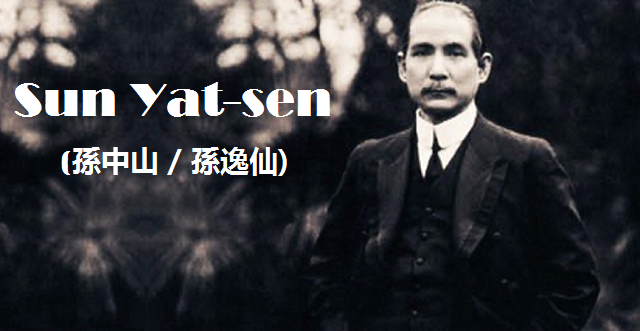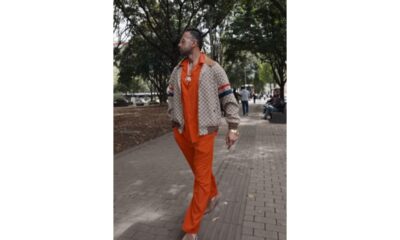Politics
Interesting Facts about Chinese politician Sun Yat-sen, known as Father of Modern China

Sun Yat-sen’s Birthday is an unofficial holiday in Taiwan, that is recognized on November 12. The holiday is otherwise called Doctor’s Day since Sun Yat-sen was likewise a doctor. He is referred to as the “Father of the Nation” in the Republic of China or “National Father of Modern China” for his instrumental role in the overthrow of the Qing dynasty during the Xinhai Revolution. Sun Yat-sen (孫中山 or 孫逸仙) is extraordinary among 20th-century Chinese leaders, politicians, doctors, and political philosopher, for being generally venerated in both mainland China and Taiwan.
Here is a look at the life and work of the Former President of the Republic of China Sun Yat-sen (孫中山 or 孫逸仙)
Personal
- Birth name: Sun Deming (孫德明)
- Birthdate: 12 November 1866
- Birthplace: Cuiheng, Guangdong, Qing dynasty
- Died on: 12 March 1925 (aged 58)
- Dead place: Beijing, Republic of China
- Resting place: Sun Yat-sen Mausoleum, Nanjing, Jiangsu, People’s Republic of China
- Father name: Sun Dacheng
- Mother name: Madame Yang
- Spouse(s):
- Lu Muzhen (m. 1885; div. 1915)
- Kaoru Otsuki (m. 1903–1906)
- Soong Ching-ling (m. 1915–1925)
- Children:
- Son Sun Fo (b. 1891)
- Daughter Sun Jinyuan (b. 1895)
- Daughter Sun Jinwan (b. 1896)
- Daughter Fumiko Miyagawa (b. 1906)
- Nationality: American, Chinese, Qing
- Sun sign: Scorpio
- Political party: Kuomintang
- Other political affiliations: Chinese Revolutionary Party
- Education:
- Cuiheng elementary school
- Iolani high school
- Oahu College (Hawaii)
- Government Central School (Queen’s College), Hong Kong
- Hong Kong College of Medicine for Chinese (MD)
- Famous as: Chinese Revolutionary figure, “Father of the Nation”
- Known for: Philosopher, physician, politician
- Notable award: Grand Merit Order (Awarded by President Yuan Shikai but declined by Sun himself)
Facts about Sun Yat-sen (孫中山 or 孫逸仙)
- Sun Yat-Sen (孫中山 or 孫逸仙) was born on 12 November 1866 in a peasant family in the Village of Cuiheng Xiangshan County close to Macau.
- In the wake of finishing primary education, Sun Yat-sen moved to Honolulu to live with his elder brother Sun Mei, who had become an affluent trader there. With his brother’s financial support Sun Yat surrendered his professional career and dedicated himself to the revolutionary activities.
- At first not equipped for communicating in the English language, Sun Yat-sen studied English, mathematics, and science at the Iolani School in 1882 and got a prize for his exceptional presentation in English.
- After getting citizenship in America Sun Yat-sen tried out Oahu College in Hawaii and graduated from there.
- From the earliest starting point, Sun Yat-sen was exceptionally inspired by Abraham Lincoln’s idea of republicanism; the government of the people, by the people, for the people. Because of a similar, he figured his three principles of people generally known as nationalism, socialism, and sovereignty.
- Later in life, Sun Yat-sen drafted two books that echo these ideas; The Vital Problem of China (1917) and the International Development of China (1921).
- Sun Yat-sen (孫中山 or 孫逸仙) brutally reprimanded colonialism and discarded the idea of Marxism announcing that the goal of the Three Principles of People is to create communism and anarchy in the society.
- In the interim, Sun Yat-sen returned to China in 1883 for at some point and what he found in a backward China deeply moved him, making him disdainful towards Chinese religious beliefs.
- Dreading a fury among his fellow village people he abandoned Hong Kong where he changed over to Christianity and was baptized by an American Missionary. There, he studied English at the Anglican Diocesan Home and was moved to the Central School of Hong Kong in 1884.
- Sun Yat-sen additionally studied medicine and acquired a license of medical practice from the Hong Kong College of Medicine for Chinese in 1892.
- At age 20, Sun Yat-sen married a village girl Lu Muzhen with whom he had three children, including two daughters.
- Sun stepped into revolutionary activities when the Qing government received an incredibly moderate methodology in promoting advanced techniques and education in China. He surrendered his medical practice to contribute to the transformation of China into a western-style constitutional power.
- Sun Yat-sen (孫中山 or 孫逸仙) founded the Revive China Society in 1894 as his initial move towards a full fledges revolutionary activity to deliver a Republic China.
- Sun was given an exile for 19 years after a coup he plotted failed in 1895.
- During the period, Sun Yat-sen went to Europe, the United States, Japan, and Canada raising funds for his revolutionary activities and joined a dissenter Chinese group in Japan, where he spent the most extreme years of exile.
- After spending very nearly ten years in Japan, Sun Yat-sen went to the United States.
- On 10 October 1911, a military rebellion at Wuchang finished more than a thousand years of government in China. Sun Yat got back to China and was elected as the provisional President of the Republic of China in a meeting of delegates from provinces on 29 December 1911.
- Sun Yat-sen’s revolution had seen a series of defeats before the foundation of the Republic of China and with the newly discovered achievement of the revolution, Sun became known as the National Father of Modern China.
- Known as the Father of Modern China, Sun Yat-sen played a key role in nullifying the Qing Dynasty in China and was the first provisional president of the Republic of China when it was first set up in 1912.
- His Method and Strategies of Establishing the Country came in 1919, proposing his plan to promote peace, freedom, and equality in China.
- After expecting the power, Sun Yat-sen required the leaders of all provinces to elect new senators to set up the National Assembly of the Republic of China.
- In 1913 Sun led a futile coup against Yuan, the head of the Beiyang Army, whom he had guaranteed the presidency of the New Republic on the off chance that he helped him annul the Qing Emperor.
- Failing his promise, Yuan had announced himself the new emperor to Sun’s disdain. Be that as it may, his dictatorship reached a conclusion in 1916 and he had to venture down from the throne. After the failed coup of 1913, Sun ran away to Japan where he reorganized the Kuomintang.
- On 25 October 1915, Sun Yat-sen married Soong Ching-ling without divorcing his first spouse Lu Muzhen, regardless of furious resistance from the Chinese community.
- Incensed by the division, Sun got back to China in 1917 and set up a military government in Guangzhou, Southern China in 1921 to battle for its unification.
- Sun Yat-sen (孫中山 or 孫逸仙) was elected as President and generalissimo of the military government.
- As per a speech delivered by Sun Yat-sen in Hong Kong in 1923, it was the corruption and disorder of China and a steady administration of Hong Kong that made a revolutionary within him.
- Sun Yat-sen portrayed his Three Principles of the People as the fundamental rules for a steady government. The part of his famous speech in Hong Kong made its presence into the National Anthem of the Republic of China.
- Sun Yat built the Whampoa Military Academy close to Guangzhou to battle military forces. In any case, the authenticity of the militarist government was addressed and contradicted by the Beiyang Government based on the constitution and its policies.
- Sun Yat-sen was reappointed as the president of the Kuomintang on 10 October 1919 and stayed in his position until 12 March 1925.
- Having failed in his initial efforts, Sun left on uniting partnerships with Chinese socialists and embraced a policy of Active Corporation.
- Sun Yat-sen (孫中山 or 孫逸仙) saw the Military powers as the only weapon to bind together China and build up a democracy in the nation.
- In his later life, Sun actively took an interest in getting organizing seminars and gave an extensive speech calling upon Chinese individuals to talk about the eventual fate of the nation regardless of his worsening health.
- After delivering a speech in North on 10 November 1924 Sun gave another renowned speech in Japan on the 28th of the month and started a peace talk with the Northern leaders on the unification of China.
- Even though Sun Yat-sen didn’t live to see his country bound together for he passed on of Liver cancer on 12 March 1925 in a hospital in Beijing.
- Known as a Chinese nationalist and proto-socialist Sun Yat-sen is respected as the Forerunner of the Chinese Revolution, who lived and died for a cause.
- His name is referenced in the preface to the Constitution of the People’s Republic of China as an honor to him.
- Sun Yat-sen’s belief system, famous known as “The Three Principles of the People”, the political philosophy of nationalism, democracy, and socialism is one of his legacies to the individuals of China and Taiwan where he is loved for his revolutionary efforts.
-

 Sports4 weeks ago
Sports4 weeks agoAl Ahly vs Inter Miami, 2025 FIFA Club World Cup – Preview, Prediction, Predicted Lineups and How to Watch
-
Health3 weeks ago
Back to Roots: Ayurveda Offers Natural Cure for Common Hair Woes
-

 Tech3 weeks ago
Tech3 weeks agoFrom Soil to Silicon: The Rise of Agriculture AI and Drone Innovations in 2025
-

 Startup4 weeks ago
Startup4 weeks agoHow Instagram Is Driving Global Social Media Marketing Trends
-

 Sports3 weeks ago
Sports3 weeks agoFIBA 3×3 World Cup 2025: Full Schedule, Preview, and How to Watch
-

 Science4 days ago
Science4 days agoJuly Full Moon 2025: Everything You Should Need to Know, When and Where to See Buck Moon
-

 Gadget3 weeks ago
Gadget3 weeks agoThings to Know about Samsung Galaxy S26: What’s New and What’s Next
-

 Sports4 weeks ago
Sports4 weeks agoWorld Judo Championships 2025: Full Schedule, Date, Time, Key Athletes and How to Watch













